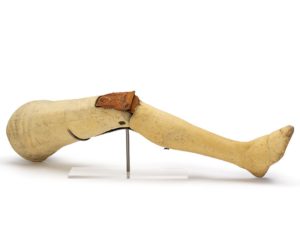The Surgeon’s Blade: Limbless but Lucky
March 27, 2017 - Mick Crumplin in News & Blog Posts, The Surgeon's Blade
Mick Crumplin continues his medical blog by looking at famous amputations and the curious tale of Lord Uxbridge's leg
Three out of four surviving casualties in the French wars were hit on one or more of their limbs. Most were injured by small arms fire. Amputation of arm or leg would lead to a pension or sometimes, a miserable pauper’s life or even become a ‘badge of honour’ for the veteran.
Lieutenant Colonel Henry Hardinge was wounded in the hand at the Battle of Ligny and after he had his left hand amputated at the wrist, at the Roi d’Espagne Inn in Genappe, he was disturbed by having to lie all night with the amputated part lying beside him.
Rear Admiral Horatio Nelson underwent an above elbow amputation for a missile injury during an assault at Tenerife in July 1797. When asked what should be done with his right arm, he directed that it should be thrown into a shroud (a weighted hammock) with the corpse of a sailor who had died fighting alongside him at the mole on Santa Cruz.
Perhaps the most notorious amputation of the war was that operation performed on Henry Paget, Lord Uxbridge, Wellington’s cavalry commander. In the dusk at Waterloo an iron case round passed over the neck of Wellington’s charger, Copenhagen and smashed into Paget’s right knee joint, thus narrowly missing the Duke.
The apocryphal interchange of words between the Duke and Paget was traditionally, “By God, sir, I’ve lost my leg!” to which Wellington replied “By God, sir, so you have!” Horace Seymour, one of Uxbridge’s aides however, remembered otherwise. Seymour was the man who helped carry the wounded Uxbridge from the battlefield. He recalled that when Uxbridge was hit he exclaimed, “I have got it at last,” to which the Duke of Wellington responded, “No? Have you, by God?”
Uxbridge was sent to Maison Tremblant in Waterloo, a house owned by a M. Hyacinthe Joseph-Marie Paris. After seeking two second opinions, Wellington’s Scots personal physician and surgeon, John Robert Hume, performed an above-knee amputation with flaps.
During this ordeal, Paget uttered barely a sound and his pulse remained rock steady. Shortly after surgery Paget requested a senior cavalry colleague to inspect the limb and check that the wound had been worthy of amputation! The leg was buried in Maison Tremblant’s garden under a willow tree. This shrine and the bloody chair on which Paget had sat for his surgery, attracted thousands of visitors, who were charged for the privilege of viewing these macabre relics!
Around 1878, the bones were exposed after the willow tree was blown down in a storm. A dispute arose between Monsieur Paris’s widow and the Paget family, who had wished the remains repatriated. In 1934, after the hidden bones were found by a later member of the Paris family living in Brussels, they were incinerated in a domestic heating furnace, to avoid further scandal.
One of Uxbridge’s false legs, known as the ‘Anglesea leg’, articulated by kangaroo tendon, was well constructed, allowing flexion of the foot when the knee was bent. This type of prosthesis was used for many years after Waterloo.
Mick Crumplin is the author of The Bloody Fields of Waterloo: Medical Support at Wellington’s Greatest Battle. Email [email protected] for more information.
Save




